Advantages of a New Approach to XPU-Mounted Power
By overcoming the obstacles imposed on CPUs or GPUs (or simply XPUs) by external high current delivery through the “last inch,” Vicor Power-on-Package technology does more than just improve performance and simplify motherboard design.
It enables XPUs to achieve previously unattainable performance levels that are necessary to fulfilling the promise of high-performance applications such as Artificial Intelligence.

Power-on-Package Delivers Hundreds of Amps of Steady Power Previously Unavailable to High-Performance Applications

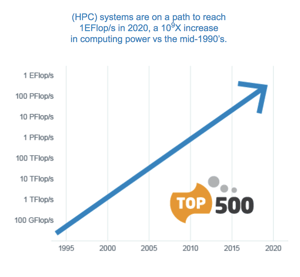 In response to the ever-increasing demands of high performance applications – artificial intelligence, machine learning, big data mining – XPU operating currents have risen to hundreds of Amperes. Point-of-Load power architectures in which high current power delivery units are placed close to the XPU mitigate power distribution losses on the motherboard but do nothing to lessen interconnect challenges between the XPU and the motherboard. With increasing XPU currents, the remaining short distance to the XPU – the “last inch” – consisting of motherboard conductors and interconnects within the XPU socket has become a limiting factor in XPU performance and total system efficiency.
In response to the ever-increasing demands of high performance applications – artificial intelligence, machine learning, big data mining – XPU operating currents have risen to hundreds of Amperes. Point-of-Load power architectures in which high current power delivery units are placed close to the XPU mitigate power distribution losses on the motherboard but do nothing to lessen interconnect challenges between the XPU and the motherboard. With increasing XPU currents, the remaining short distance to the XPU – the “last inch” – consisting of motherboard conductors and interconnects within the XPU socket has become a limiting factor in XPU performance and total system efficiency.
The new Vicor Power-on-Package Modular Current Multipliers (“MCMs”) fit within the XPU package to expand upon the efficiency, density, and bandwidth advantages of Vicor Factorized Power Architecture, already established in 48V Direct-to-XPU motherboard applications by early adopters.
Meeting the Challenge that Conventional Point-of-Load Voltage Regulators Cannot
Conventional motherboard placed VRs can limit the XPU’s full running potential, with limits to current delivery demands necessary for maximum performance. The XPU will “pull back” operating frequency and transient events due to these limits. Between the VR and the XPU is a complex impedance called the power delivery network, which is composed of motherboard PCB and socket interconnect impedances. This power delivery
network creates added losses and hinders the VR in providing power to the XPU.
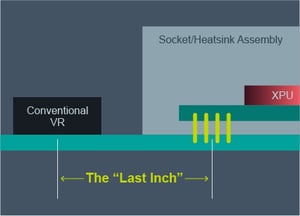
The Last Inch in the Power Delivery Network
Resistance between the VR and XPU can total several hundred µΩ. Power loss becomes sizable with XPUs having ~200A average current consumption and a peak current of ~2x the average current.
Conventional Power Delivery Underperforms at Higher Demand
- The number of pins needed for power delivery, limiting additional I/O capability, will continue to grow
- Greater power delivery losses on the motherboard
- Inability to scale to meet peak power demands
- Design complexity necessary to overcome a complex power delivery network
Power-on-Package Eliminates the “Last Inch”
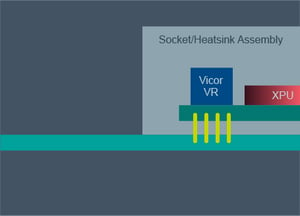

Power-on-Package practically eliminates the power delivery network by moving high current delivery from the VR off the motherboard and places it adjacent to the XPU, eliminating the “last inch.”
Delivering 48V to the XPU socket minimizes the number of pins needed for power and current delivery isreduced by 98% from 200A to 4A. Unlike conventional VRs, Power-on-Package is the only solution with the required density to allow it to be placed in the available space on the XPU substrate.
Power-on-Package Solution Modules for 320A Continuous Output Current |
|
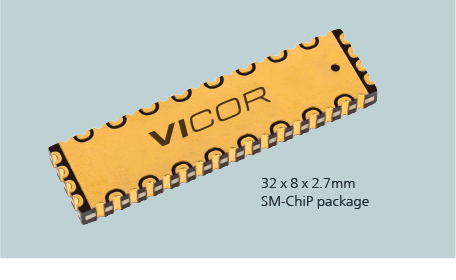 |
 |
|
MCM3208S59Z01A6C00
|
MCD3509S60E59D0C01
|
Power-on-Package Solution Modules for 600A Continuous Output Current |
|
.png?width=460&name=MCM4608%20(1).png) |
.png?width=460&name=MCD4609%20(1).png) |
|
MCM4608S59Z01B5T00
|
MCD4609S60E59H0T00
|
Gyoukou Supercomputer leveraging 48V Factorized Power
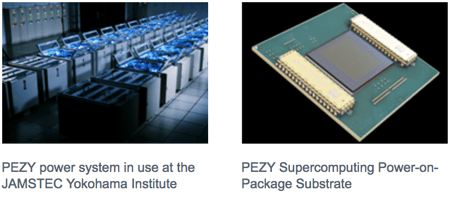
Watch the demonstration of Gyoukou, the ExaScaler/PEZY ZettaScaler-2.2 liquid immersion cooling supercomputer with a November 2017 Top500 ranking of #5 reported at 19.1PFlop/s and a Green500 ranking of #4 reported at 14.1GFlops/Watt. Each tank within the system is comprised of 256 processors and utilizes 48V Factorized Power, a high-efficiency, high-density power distribution architecture. PEZY CPUs are co-packaged with Vicor Power-on-Package (“PoP”) Modular Current Multipliers (“MCMs”) which enable efficient, direct 48V to sub-1V current multiplication at the XPU. The Gyoukou supercomputer is installed at the JAMSTEC Yokohama Research Institute in Japan.

